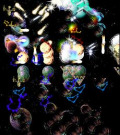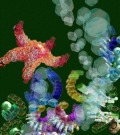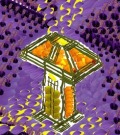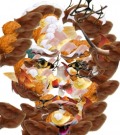| Author | Comment | |
|
1. 4 May 2010 14:26 |
|
|
chelydra
 |
After the ferociously uncompromising High Cubist creations of Picasso and Braque - I mean those gray-brown-black fragmentations of 1908 and 1909 - about a dozen other excellent painters saw what those two were up to, and turned it into something beautiful. So far as I know, they didn't produce any manifestoes or give their movement a nickname, so I'll call it Mild Cubism.
Here are some names:
Robert Delaunay
Roger De la Fresnaye (I think that's the right spelling)
Jacques Villion (brother of Marcel Duchamp, or maybe cousin)
John Marin
Arthur B. Carles
Juan Gris should probably be included in this list but his style was a bit different from what I had in mind. Henri Matisse, too, did a number of magnificent huge canvasses influenced by cubism (several share a room at MoMA in NYC, the boy with piano & metronome being my favorite). If you'd like to include them, or anyone else (including Picasso and Braque themselves, after 1910 or so) who you think fits this idea, go ahead.* But those I listed are softer, gentler, and not so intimidating perfect as Gris and Matisse.
Almost all the works I have in mind were produced in 1910-1914. Marin, Matisse, and Villon lived for several more decades but in my opinion never again came close to their masterpieces of those early years.
Before I continue (since I tend to run on and on), here's the Challenge: Make pictures in the manner of Mild Cubism. Do NOT just copy work by those guys! Instead, use their approach to create fresh pieces, which can include transformations of other pictures (paintings or photos) - i.e., make a Mild Cubist reinterpretation of an Old Master, or whatever.
I'll continue my introductory remarks in a separate message, since I don't want you to get bogged down in my verbiage if you're already rarin' to go. Start looking and drawing, and read the rest later! (One picture being worth 1,000 words, and all that.)
________________
* If you're thinking of Marc, Feininger, Klee, Leger, Metzinger, or the Futurists, they're good but only the first two are what I'd call Mild Cubists.
|
|
2. 4 May 2010 15:37 |
|
|
chelydra
 |
To really get a grip on what Cubism was all about, you may need to have a glance at how Cezanne's paintings evolved. Cezanne was perhaps the only artist who single-handedly gave us a whole new way of seeing (although it was foreshadowed in some loose, rough, informal drawings by Rembrandt and others). Picasso and Braque acknowledged a deep debt to Cezanne, who was probably a better cubist (with a small C) than they ever were, even though he died about five years before Cubism (big C) was born.
It's all about analyzing space. But this requires perceiving space — if you don't see it, you can't very well analyze it. Wait! I take that back — you can also feel space, whenever you explore anything with your hands or feet. In fact, the sense of touch is at least as important as vision in developing your depth perception.
Contrary to popular belief, what we call "perspective" (that is, "classical" or "scientific" perspective) is NOT the same thing as depth perception. It's part of it, but by itself it falls far short of the mark. Any camera 'sees' the world in perfect perspective. All photographs can be diagrammed to show a picture plane, a vanishing point (or two or three), and so forth. A standard camera has only one 'eye', and a single point of view. Visual depth perception requires two eyes. More importantly, it requires a brain where these two views (from slightly different points in space; your eyes are about three inches apart) are combined into something quite magical. (Stereoscopic cameras, with two lenses, will do the trick, but actually the trick takes place in the brain.)
Because our brains get lazy, or get filled up with too much other stuff, they rarely do a very good job of producing depth perception. Also, most of us are in the habit of letting one eye dominate our vision, so we don't get two equally powerful, assertive images forcing our brains to do their job. And when we spend our days and nights gazing at flat rectangular screens, and flat rectangular printed papers, our world is reduced to two dimensions anyway. (Those rectangular boundaries are important too, since they render our peripheral vision irrelevant. More about that later.)
Here's a neat trick for waking up your depth perception. It takes about five seconds, but what it reveals is worth about two years of art schooling in terms of enhancing the power of your eyes and brain. On your mark... get set...
Here's what you do: Simply close one eye (either one) and have a look around you. (It hardly matters where you are. A cluttered desktop or kitchen will do; so will a forest.) If you want, you can do the same with the other eye (but only one eye at a time). Okay? Now... GO!!! Open both eyes at once!
Did it work? Repeat the exercise once or twice to make sure.
Welcome to three dimensional space. Welcome to the world of Mild Cubism! Your Third Eye is now open.
Want to take it a step further? With both (or all three) eyes now open, and all the glories of the (previously hidden or unnoticed) third dimension unfolding in front of you, allow your gaze to broaden. Without moving your head, let your forward vision get a bit indistinct, and allow your eyes and brain to take in what's way off to your left and to your right. Once this starts happening, roll your eyes around — left, right, up, down — blinking a lot while you're at it. Your depth perception should now be growing by leaps and bounds.*
These exercises don't work for everyone. An obvious example is someone with no vision in one eye (or both for that matter). But even for people with perfect eyesight, it helps to carry on this process by means of touch. Use your fingers to feel your own face, and the back of your head too. (You can do this first without a mirror, and then with one.) Imagine making a sculpture, or some kind of drawing, based only on feeling the subject, not seeing it. Just like your visual cortex, the brain's touch center seems to have a sub-department devoted to spatial perception, known as 'proprioception'. Ideally, you'll now have depth perception happening full-blast all over your brain!
Okay, now go to work!
______________
* "Leaps and bounds" are crucial in depth perception. Predators have depth perception in order to judge distances for pouncing — since they want to get it right the first time. Primates like us have depth perception in order to judge distances up in the forest canopy where we belong. Herbivores generally have their eyes on opposite sides of their heads, allowing them a near-360° view of approaching predators — but because their eyes' visual fields don't overlaps, there's no zone in which the stereoscopic effect can happen. Darwinists would claim (rightly) that any predators lacking depth perception would starve, and any primates without it would miss the branch they're jumping towards and break their necks. Those with eyes facing frontwards (with flattish faces for that purpose) would have depth perception and live to have lots of babies with similar faces.
|
|
3. 4 May 2010 15:50 |
|
|
chelydra
 |
Color is as important space in Mild Cubism — and in the work of their granddaddy Cezanne too (although notably absent from the extreme High Cubism of Picasso and Braque). These guys were digesting the color experiments of the Fauvists (circa 1904-07) as well as the spatial revolution of Cubism. I think our Mild Cubists generally fell far short of Cezanne (everyone does) in using color to define three-dimensional space. But when you embark on your own Mild Cubist pictures, remember those lush, rich, vibrating color harmonies (Carles and Villon especially).
|
|
4. 4 May 2010 16:25 |
|
|
chelydra
 |
An excellent web page called "Artists You Should Know About If You Don't Already" includes a wonderful sampling of (mostly 20th Century) painters, with very well-chosen mini-portfolios. Arthur B. Carles and John Marin are both represented nicely. There are many more I've never heard of (but should have!) and most of those I thought I knew well enough already turn out to be better than I thought. Inspirational!
|
|
5. 4 May 2010 16:26 |
|
|
chelydra
 |
URL for the above:
http://www.ramonacreel.com/List.asp?List=1
|
|
6. 4 May 2010 16:47 |
|
|
chelydra
 |
I found this page whilst seeking Delaunays. There's one here, but also another painting I like better by Olga Rozanova — City on Fire, 1914. Never heard of her before. I think there are some other female M ild Cubists whose names escape me. Arthur B. Carles's daughter, Mercedes Matter, might be considered a (later, partial) Mild Cubist; there a nice assortment of her figure drawings on YouTube. Her friend Alberto Giacometti wasn't exactly a Mild Cubist, but his paintings powerfully demonstrate what I was trying to write above about depth perception.
http://www.courtauld.ac.uk/researchforum/projects/archaeologies-stand/turel02/index.shtml
|
|
7. 4 May 2010 16:52 |
|
|
chelydra
 |
Just wanted to clarify the last message is about the Courtauld Gallery web site, not the web site mentioned in preceding one.
Starting to feel like I'm hosting a party with no guests, but here I am singing and drinking away, with the ghosts of all those Mild Cubists providing friendly company.
|
|
8. 4 May 2010 18:53 |
|
|
Qsilv
 |
hmmm.... just how important is it to geometricize the shapes?
...and, um, about those thick black outline-y bits that admittedly can (but seldom enough do) help to make the colors float...?
|
|
9. 4 May 2010 19:07 |
|
|
chelydra
 |
Wandered off for a couple hours and return to find the ghosts trying to amuse themselves, not very successfully. It's 10:30 PM on the east coast of America, and I'd thought this place would be humming by now! (First faint hints of anxiety and depression as your host starts to wonder if becoming a TD celebrity won't resolve his identity crisis after all, and the first predawn birdsongs waft through the studio window.)
Well, before I wander off again, I guess I should pin a note to the door telling anyone who shows up to make themselves at home, be nice to the ghosts, help yourselves to anything in the ice box, feel free to spend the night in any bed you find with anyone else who arrives, or with a ghost or two.
Just a quick postscript on the note, and then I'm outa here. A few flattering comments on my TD portraits have said things about how everyone can learn from them. If you want to tap into my sources, the way to do it is to try out those depth perception exercises. I arrived at them when trying to figure out what the heck my art teachers were talking about when they said things like "The back of the head is the most important part of a portrait" (including a frontal portrait), and "Be sure to draw the space within and around the model's limbs" (or between the legs of a chair, or whatever). But how can you draw what's invisible? Is this supposed to be something like a Zen master telling his monks to listen to the sound of one hand clapping or what? It took a while, but I finally realized they were just talking about depth perception, a.k.a. stereoscopic vision. Probably the best example of depth perception in action on the TD site isn't in anything I've done, but in a recent head or two created by artdillon - the part of the head you don't see is making its presence powerfully felt. For a subtler, more abstract evocation of space, check out five's 'tree with nest' — she did it with just a black gothic silhouette too.
Okay, enjoy yourselves (if you ever show up that is). I'll check in eventually, but won't say anything more until you arrive (if you do), since this echo's starting to get to me, and I'm starting to doubt whether even those ghosts are around.
|
|
10. 4 May 2010 19:09 |
|
|
Qsilv
 |
...(ahem..) ...?
|
|
11. 4 May 2010 19:09 |
|
|
chelydra
 |
Omigosh! and to think that I ALMOST added Qsliv to my shortlist of depth-perceiving TDers (but can never recall ofhand how to spell that name)!
Gotta think about your question, Q, before attempting a reply.
|
|
12. 4 May 2010 19:11 |
|
|
chelydra
 |
Don't go away! I'm still thinking! (Trying to start thinking at least.)
|
|
13. 4 May 2010 19:14 |
|
|
Qsilv
 |
It's an interesting challenge/exercise, chelydra. No doubt it WILL scare of some, but they'll ease back in when examples start showing up.
As for me, I'm not properly trained, just stubborn, so my questions are legit, and I appreciate your taking the time to work out some answers.
;>
|
|
14. 4 May 2010 19:18 |
|
|
Qsilv
 |
+f = off
and I'll be up quite a while yet, working on stuff I'm behind on, so I'll keep an eye on stuff here --and yes, toss more of my business on the altar to play at your game!
|
|
15. 4 May 2010 19:26 |
|
|
chelydra
 |
Q: Geometricized shapes are probably pretty basic to notion of Mild Cubism, but the 'geometry' can take a whole lot of different forms or directions. John Marin and Robert Delaunay did some pretty violent deconstructions of the Singer & Woolworth Buildings, and the Eiffel Tower, respectively, with wild sharp diagonal beams flying around, slicing through the air. On the other hand, Jacques Villon used graceful arcs, and kept everything within his elegant "Golden Mean" proportions. (The Golden Mean! Damn, now I'm wishing THAT had been the challenge subject!) Villon and Carles tended to keep their forms coherent and stable. I like both approaches myself; do what you want, including any other approach you discover on your own. To be continued in a moment.
|
|
16. 4 May 2010 19:43 |
|
|
Qsilv
 |
The thing is, I don't much LIKE rectilinear geometrics. They aren't how my hand sees the world.
Altho' I noticed a preponderance of "abstract expressionism" in the ones I had available for Shanley's "Exploring Art" challenge, most everything I do winds up involving arcs.
But you're right, I am verrrry conscious of depth, of the sculptural qualities of objects... no matter whether solid or floaty-translucent my mind is always seeing "through" them and around behind them.
To MY mind, my latest Tidepool thing fulfills your criteria.... and yet... it doesn't look anywhere near as demi-cubist as my lamp thing.... or even my mechanism thing.
So now I'm confused.
 http://www.thinkdraw.com/picture.php?pictureId=103378 - Tidepool Jewels http://www.thinkdraw.com/picture.php?pictureId=103378 - Tidepool Jewels
 http://www.thinkdraw.com/picture.php?pictureId=75960 - leftover Tuesday by Lamplight http://www.thinkdraw.com/picture.php?pictureId=75960 - leftover Tuesday by Lamplight
 http://www.thinkdraw.com/picture.php?pictureId=26297 - Mechanism of Balance http://www.thinkdraw.com/picture.php?pictureId=26297 - Mechanism of Balance
|
|
17. 4 May 2010 19:45 |
|
|
chelydra
 |
"...and, um, about those thick black outline-y bits that admittedly can (but seldom enough do) help to make the colors float...?"
This is harder, because I can't think offhand of what examples you'd have in mind. Lyonel Feininger used a lot of lines - his painting are mostly made of long thin straight lines, just coloring in the shapes they form by intersecting — are those floating colors? Max Beckmann perhaps produced another (highly individual) version of Mild Cubism, quite unlike those cited so far, and he definitely had a lot of heavy black lines and floating colors, but I doubt if were you thinking of him — I wasn't until now.
Or maybe you were thinking more of the grim, monochromatic High Cubism of Picasso & Braque, circa 1908? They did rely on linear thingis, defining the edges of their floating fragments (each one representing a plane of the subjects form, such as the balding head of their gallery owner, V---- (another Villon maybe?)
So I guess the answer if that black lines are entirely optional.
What I'm hoping to get in response to this challenge is evidence that people are analyzing three-dimensional space more thoughtfully than we usually do. And PLAYING WITH IT! Mild Cubism is PLAYFUL! There's some brain-strain in getting the hang of it, but it's also FUN! Those folks on my list of Mild Cubists were all having a ball. Cartoony pix ARE totally acceptable.
|
|
18. 4 May 2010 19:59 |
|
|
Qsilv
 |
uh huh... (dubious look toward chely... and a sudden laugh) ...so, humor me, dude: analyze those three I just stuck up there?
oh, AND this one... which is, if *I* get to have any say in it, both highly deconstructivist AND playful!
 http://www.thinkdraw.com/picture.php?pictureId=26957 - On a good day... http://www.thinkdraw.com/picture.php?pictureId=26957 - On a good day...
|
|
19. 4 May 2010 20:03 |
|
|
chelydra
 |
Q: There's plenty of leeway. I think both your Tidepool Jewels and the lamp are fine for this, as are your anemone, Wall 2, Wall 3, and a couple of others near the walls, on page 4 of your gallery. Most of your portraits too, are not far off. I guess I'd like to see your own very, very mild version of Mild Cubism become a bit less mild, try playing with space more. "Geometry" after all refers the forms of Geos, which is Greek for the planet we inhabit. That's a lot of forms! The point is the SPACES within, between, around the forms, and how these THREE-dimensional spaces relate to the TWO-dimensional surface of the canvass. I'm rarely even aware of this last point when I'm drawing, and I'm not much good at it even when I am. But I recognize it and appreciate it in others' work, and hope to see it happening in what people come up with.
|
|
20. 4 May 2010 20:11 |
|
|
chelydra
 |
By the way — in case anyone else shows up and tries to make sense of our conversation — it may be helpful to know that whenever I'm replying to Q, she's replying to me too, and they land in the wrong places, so my replies are never to whatever she last posted.
Yes, Q, that face did strike me as a pretty fine example of what I'm trying to describe. And it may be useful to keep repeating that everyone has a LOT of leeway, as long as there's some evidence that you delving into the spaces WITHIN the canvas (within the subject) and considering how you're organizing the space OF the canvas itself. In plain English, make what you're drawing look three-dimensional, at the same time as you're constructing a nice design. PLUS play around with everything so it looks a bit like what those Mild Cubists painted 97-99 years ago.
|
